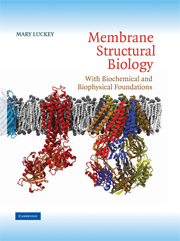Book contents
- Frontmatter
- Contents
- Preface
- 1 Introduction
- 2 The Diversity of Membrane Lipids
- 3 Tools for Studying Membrane Components: Detergents and Model Systems
- 4 Proteins in or at the Bilayer
- 5 Bundles and Barrels
- 6 Functions and Families
- 7 Protein Folding and Biogenesis
- 8 Diffraction and Simulation
- 9 Membrane Enzymes and Transducers
- 10 Transporters and Channels
- 11 Membrane Protein Assemblies
- 12 Themes and Future Directions
- Appendix I Abbreviations
- Appendix II Single-Letter Codes for Amino Acids
- Index
- References
1 - Introduction
- Frontmatter
- Contents
- Preface
- 1 Introduction
- 2 The Diversity of Membrane Lipids
- 3 Tools for Studying Membrane Components: Detergents and Model Systems
- 4 Proteins in or at the Bilayer
- 5 Bundles and Barrels
- 6 Functions and Families
- 7 Protein Folding and Biogenesis
- 8 Diffraction and Simulation
- 9 Membrane Enzymes and Transducers
- 10 Transporters and Channels
- 11 Membrane Protein Assemblies
- 12 Themes and Future Directions
- Appendix I Abbreviations
- Appendix II Single-Letter Codes for Amino Acids
- Index
- References
Summary
Essential for the compartmentalization that defines cells and organisms, biomembranes are fundamental to life. Early membranes played a crucial role in the origin of life as the structures that defined what stayed in and what was kept out of primordial cells. In addition to their compartmentalization function, membranes provide modern cells with energy derived from chemical and charge gradients, organize and regulate enzyme activities, facilitate the transduction of information, and even supply substrates for biosynthesis and for signaling molecules. Some membranes have specialized functions; for example, the brush border membrane lining the intestines absorbs nutrients, the myelin surrounding nerves functions as insulation, and the rod cell membrane of the eye captures light. While prokaryotes either have one cell membrane (Gram positive) or have inner and outer membranes in the cell envelope (Gram negative), eukaryotic cells have many membranes (Figure 1.1). In addition to the plasma membrane, eukaryotes have membranes surrounding the nucleus, organelles such as mitochondria, chloroplasts in plants, lysosomes, and of course the membrane-based endoplasmic reticulum (ER), Golgi apparatus, and other vesicles involved in intracellular transport. Even some viruses have membrane envelopes. In spite of this variety, much can be generalized about the structure and function of biomembranes.
GENERAL FEATURES OF MEMBRANES
Biological membranes consist of lipids, proteins, and carbohydrates (Figure 1.2). The lipid components include glycerophospholipids (also called phospholipids), sphingolipids, and sterols.
- Type
- Chapter
- Information
- Membrane Structural BiologyWith Biochemical and Biophysical Foundations, pp. 1 - 12Publisher: Cambridge University PressPrint publication year: 2008



